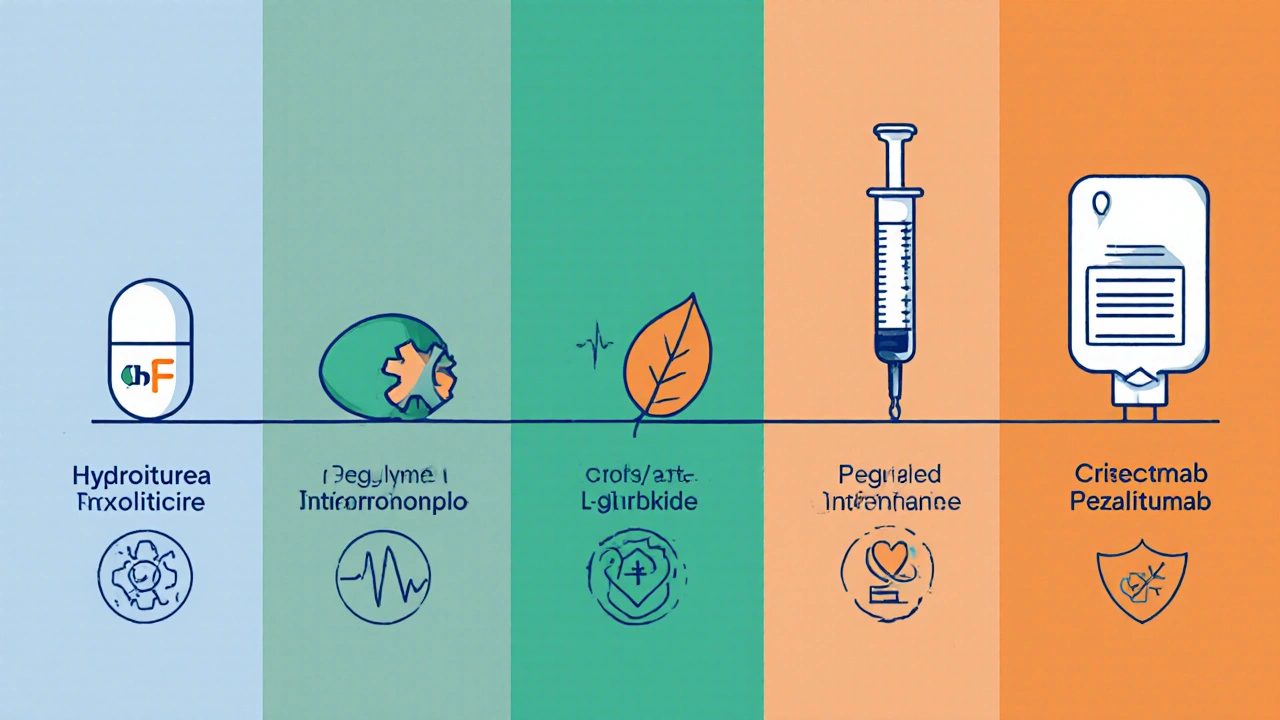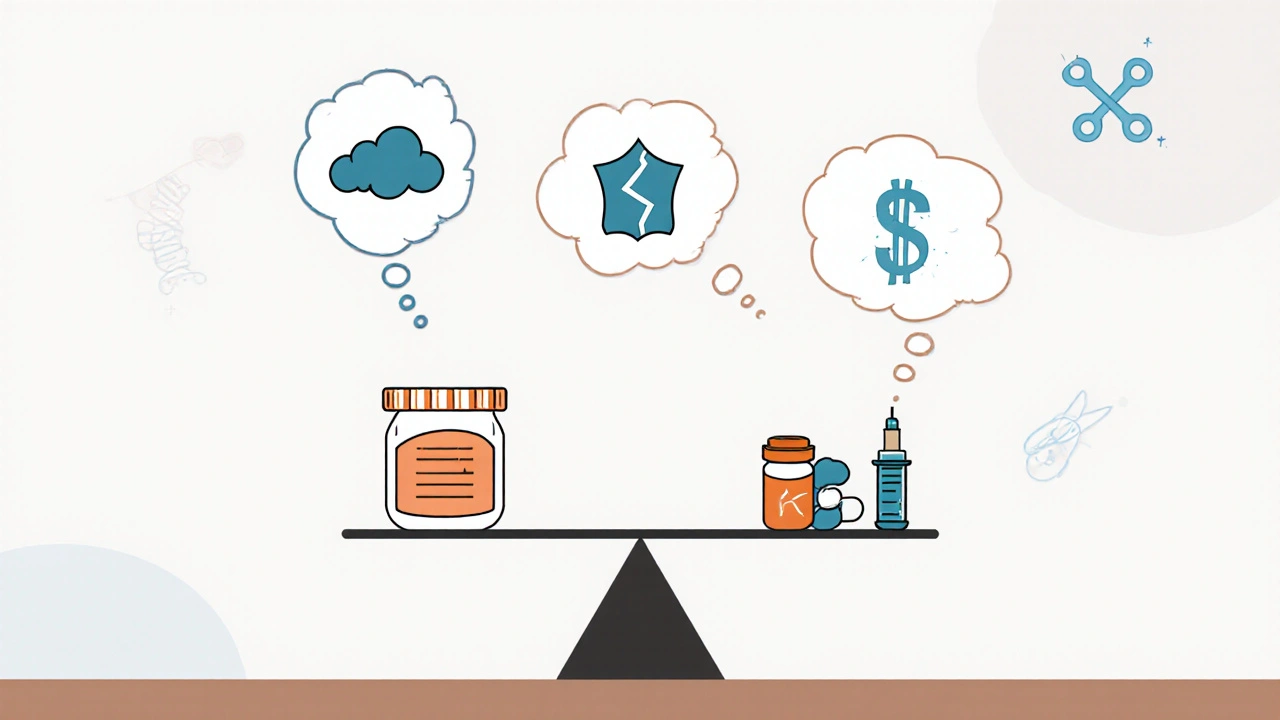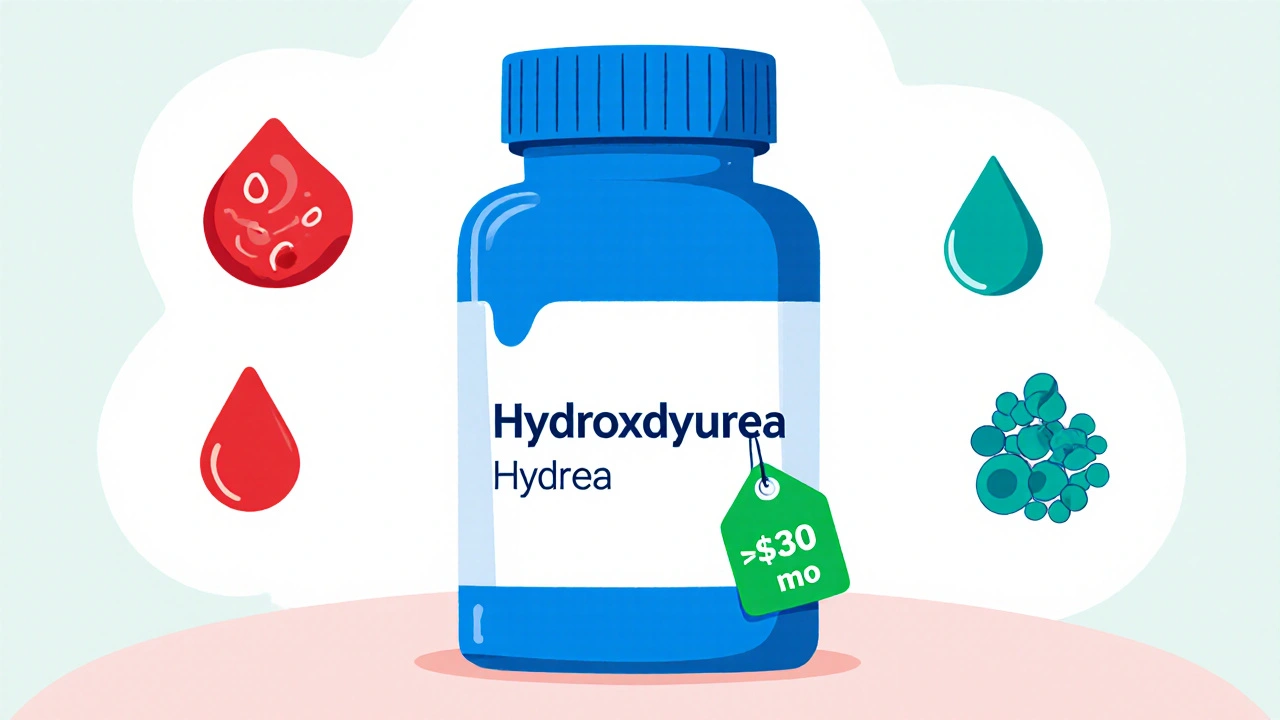Quick Takeaways
- Hydroxyurea (Hydrea) is a cheap, oral option for sickle cell disease and certain myeloproliferative disorders.
- Newer agents like ruxolitinib and crizanlizumab target specific pathways but cost significantly more.
- Choose Hydroxyurea when you need a well‑studied, easy‑to‑monitor drug with long‑term safety data.
- Consider interferon‑alpha or anagrelide if a patient cannot tolerate Hydroxyurea’s marrow suppression.
- Regular blood count monitoring is essential for all these therapies, but the frequency varies.
What is Hydroxyurea?
Hydroxyurea is an oral antimetabolite that inhibits ribonucleotide reductase, thereby reducing DNA synthesis in rapidly dividing cells. Marketed under the brand name Hydrea, it has been used for over six decades in oncology and hematology. In the United States, the FDA approved it for sickle cell disease (SCD) in 1998, and it remains a first‑line disease‑modifying therapy for many patients.
How Hydroxyurea Works
The drug’s primary action is to block the conversion of ribonucleotides to deoxyribonucleotides, slowing cell proliferation. In SCD, this leads to two clinically useful effects:
- Increased production of fetal hemoglobin (HbF), which dilutes sickle‑cell hemoglobin and reduces polymerization.
- Reduced white‑blood‑cell count, lowering inflammation and vaso‑occlusive crises.
In myeloproliferative neoplasms (MPNs) such as polycythemia vera (PV) and essential thrombocythemia (ET), Hydroxyurea curtails excess red‑cell or platelet production, controlling blood viscosity and thrombosis risk.
Key Clinical Uses
Hydroxyurea’s indications can be grouped into three major categories:
- Sickle cell disease: reduces pain crises, acute chest syndrome, and need for blood transfusions.
- Polycythemia vera: maintains hematocrit < 45% without phlebotomy.
- Essential thrombocythemia: keeps platelet counts below 400 × 10⁹/L and prevents clotting events.
Off‑label, it is sometimes used in chronic myeloid leukemia (CML) when tyrosine‑kinase inhibitors are unavailable, but this is less common.

Pros and Cons of Hydroxyurea
Advantages
- Low cost - generic versions are usually under AUD $30 per month.
- Oral administration - no injections or infusions needed.
- Long‑term safety data - >30 years of real‑world experience.
- Improves HbF levels, directly addressing the pathophysiology of SCD.
Drawbacks
- Myelosuppression can cause anemia, neutropenia, or thrombocytopenia.
- Potential skin ulcers and leg ulceration, especially in PV.
- Requires regular CBC monitoring (every 4‑8 weeks initially).
- Rare risk of leukemic transformation, though absolute risk is low.
Major Alternatives to Hydroxyurea
In recent years, several newer drugs have entered the SCD and MPN arenas. Below is a brief snapshot of the most widely used alternatives.
Ruxolitinib - a Janus kinase (JAK) 1/2 inhibitor approved for myelofibrosis and, more recently, for hydroxyurea‑intolerant PV.
Anagrelide - a phosphodiesterase‑3 inhibitor primarily used to lower platelet counts in ET.
Interferon‑alpha (Pegylated) - a cytokine that suppresses myeloid proliferation and can raise HbF in SCD.
L‑glutamine - an oral amino‑acid therapy that reduces oxidative stress in SCD.
Crizanlizumab - a monoclonal antibody targeting P‑selectin to prevent vaso‑occlusion.
Side‑by‑Side Comparison
| Drug | Primary Indication | Mechanism | Route & Dosage | Key Side Effects | Typical Cost (AUD/month) |
|---|---|---|---|---|---|
| Hydroxyurea | SCD, PV, ET | Ribonucleotide reductase inhibition → ↑ HbF, ↓ marrow proliferation | Oral, 15‑35 mg/kg daily (adjusted) | Myelosuppression, leg ulcers, gastrointestinal upset | ≈ 30 |
| Ruxolitinib | Hydroxyurea‑intolerant PV, myelofibrosis | JAK1/2 inhibition → ↓ cytokine signalling | Oral, 10‑25 mg twice daily | Thrombocytopenia, anemia, infections | ≈ 1,200 |
| Anagrelide | Essential thrombocythemia | Phosphodiesterase‑3 inhibition → ↓ platelet production | Oral, 0.5‑1 mg daily | Cardiac arrhythmia, tachycardia, fluid retention | ≈ 400 |
| Pegylated Interferon‑alpha | PV, ET, SCD (off‑label) | Immune modulation → ↓ myeloid clone, ↑ HbF | Subcutaneous, 45‑90 µg weekly | Flu‑like symptoms, depression, liver enzyme rise | ≈ 800 |
| L‑glutamine | SCD (symptom reduction) | Reduces oxidative stress in red cells | Oral, 0.3 g/kg twice daily | Diarrhea, nausea, abdominal pain | ≈ 350 |
| Crizanlizumab | SCD (prevention of vaso‑occlusive crises) | Anti‑P‑selectin monoclonal antibody → ↓ cell adhesion | IV infusion, 5 mg/kg every 2 weeks then monthly | Infusion reactions, headache, nausea | ≈ 2,500 |

When to Choose Hydroxyurea vs an Alternative
Deciding between Hydroxyurea and a newer agent hinges on three practical factors: disease severity, tolerance, and budget.
- Disease severity: For patients with frequent vaso‑occlusive crises (>3 per year) or high hematocrit in PV, Hydroxyurea’s proven HbF boost and cytoreduction make it first‑line.
- Drug tolerance: If CBCs fall below safe thresholds (e.g., neutrophils < 1.5 × 10⁹/L), consider switching to ruxolitinib (less myelosuppression) or interferon‑alpha (different toxicity profile).
- Financial considerations: In public‑funded health systems like Australia’s Medicare, Hydroxyurea is fully subsidised, while drugs such as crizanlizumab require special authorization and out‑of‑pocket expense.
In pediatric SCD, many clinicians start Hydroxyurea as soon as the child is 9 months old, reserving expensive monoclonal antibodies for those who continue to have >2 crises per year despite optimal dosing.
Practical Tips for Starting and Monitoring Hydroxyurea
- Baseline labs: CBC with differential, renal & liver panels, and pregnancy test (if applicable).
- Starting dose: 15 mg/kg once daily for SCD; 20 mg/kg for PV/ET. Adjust upward every 4 weeks to the maximum tolerated dose.
- Monitoring schedule: CBC every 4 weeks for the first 3 months, then every 8‑12 weeks once stable.
- Response markers: For SCD, aim for HbF > 15 % and a ≥ 50 % reduction in crisis frequency. For PV/ET, keep hematocrit < 45 % and platelets < 400 × 10⁹/L.
- Managing side effects: If neutropenia occurs, hold the drug for 1 week, then resume at a 5‑10 mg reduction. Treat leg ulcers with compression and wound care; consider switching if they persist.
Future Directions
Research is exploring combination therapy-Hydroxyurea plus crizanlizumab-to see if dual mechanisms further cut crisis rates. Gene‑editing (CRISPR‑Cas9) remains experimental but may someday replace lifelong drug therapy for SCD altogether.
Frequently Asked Questions
Can I take Hydroxyurea if I’m pregnant?
Hydroxyurea is classified as Pregnancy Category D because animal studies show risk to the fetus. It is generally avoided unless the benefit clearly outweighs the risk, and any decision should involve a hematologist and obstetrician.
How quickly does Hydroxyurea raise fetal hemoglobin?
Most patients see a measurable rise in HbF within 2‑3 months of reaching a stable dose; the plateau is usually reached by 6‑12 months.
Is regular blood testing required for all alternatives?
Yes, but the frequency varies. Ruxolitinib and interferon‑alpha need CBCs every 4‑6 weeks initially, while L‑glutamine and crizanlizumab have less stringent labs, focusing mainly on liver function.
Can I switch from Hydroxyurea to Crizanlizumab without a washout period?
Because their mechanisms don’t overlap, most clinicians transition directly, but they still monitor CBCs for a month after the switch to catch any lingering myelosuppression.
What’s the biggest barrier to using newer agents in Australia?
Funding and PBS (Pharmaceutical Benefits Scheme) listing. Hydroxyurea is fully subsidised, whereas drugs like crizanlizumab require special authority applications and can cost thousands of dollars per infusion.


Comments (7)
Hydroxyurea-indeed, a cornerstone-offers an impressive cost‑benefit ratio; however, one must not overlook the subtleties of marrow suppression, especially in patients with borderline counts, which, frankly, can be a deal‑breaker.
Totally love how hydroxyurea stays affordable, especially for folks who can’t afford pricey monoclonals. It’s the real MVP for many sickle cell patients.
Hydroxyurea works, but if you can’t tolerate the blood count drops, look elsewhere.
When evaluating hydroxyurea against newer agents, one must first acknowledge its historic pedigree, having been employed for over six decades across oncology and hematology. Its mechanism-ribonucleotide reductase inhibition-is both elegant and multifaceted, simultaneously elevating fetal hemoglobin while tempering leukocyte proliferation. The clinical ramifications of these dual actions are profound, as evidenced by reductions in vaso‑occlusive crises and thrombotic events. Moreover, the drug’s oral administration simplifies adherence, a factor that cannot be overstated in chronic disease management. Cost considerations further amplify its appeal; the generic price point remains a fraction of that demanded by JAK inhibitors or monoclonal antibodies. Safety data, accrued over countless real‑world cohorts, reveal a reassuring profile, with myelosuppression being the most salient adverse event. Monitoring protocols are well‑established, typically involving complete blood counts every four to eight weeks during titration. Importantly, hydroxyurea’s impact on fetal hemoglobin can be quantified, often exceeding a 15 % threshold within six months of optimal dosing. In polycythemia vera, the drug maintains hematocrit below 45 % without the need for frequent phlebotomies, thereby enhancing patient quality of life. For essential thrombocythemia, platelet counts are reliably curtailed, mitigating hemorrhagic and thrombotic risks. While the specter of leg ulcers looms, especially in the PV population, diligent wound care and dose adjustments usually resolve the issue. The theoretical risk of leukemic transformation, though statistically minute, warrants vigilance but should not deter utilization in appropriate candidates. Comparatively, agents such as ruxolitinib and crizanlizumab, while mechanistically innovative, impose substantial financial burdens on healthcare systems. Their side‑effect spectra, including infection susceptibility and infusion reactions, further complicate therapeutic decision‑making. In sum, hydroxyurea remains a first‑line, evidence‑based, and economically sound option for a broad spectrum of patients, provided that clinicians adhere to rigorous monitoring and dose titration protocols.
Hydroxyurea? It’s the “American” medicine that works for the *real* patients-no need for those overpriced foreign drugs! 💪💉 If you can’t handle the side effects, maybe you’re not cut out for this disease. 😤
Hydroxyurea can truly change a life; imagine fewer pain attacks and more time with family-it's that powerful.
Indeed, the extensive data supporting hydroxyurea’s efficacy underscores its continued relevance in contemporary practice. 😊 Clinicians should feel confident prescribing it when indicated, while also remaining vigilant to laboratory trends.